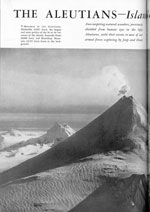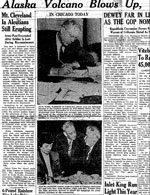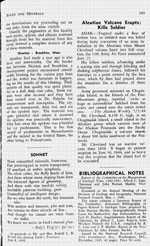Cleveland 1944/6
Start: June 10, 1944 [1]
Stop: June 13, 1944 [2]
Event Type: Explosive
Max VEI: 3 [3]
- Tephrafall [2]
- "Fire", "Glowing", or incandescence [8]
Description: The eruption is summarized by Miller and others (1998) as follows: "The 1944 eruption was characterized by two days of Vulcanian explosive activity from the central crater, which produced lava flows as well as tephra (Simkin and Siebert, 1994). Severe earthquakes were felt throughout the episode. Clouds of steam and ash rose to 6000 m and lava flows extended 5 km from the central crater. Boulders 'as big as automobiles' were ejected across the island and for a considerable distance into the surrounding ocean (Alaskan Sportsman, 1944; Freiday, 1945). This eruption of Mt. Cleveland has the infamous distinction of having resulted in the only reported historical fatality [directly] attributable to volcanic activity in Alaska. A small detachment of the Eleventh Army Air Force was stationed on Chuginadak Island and one soldier who apparently advanced too close to the active vent during a reconnaissance investigation was killed (Smithsonian Institution, 1985); the soldier was possibly killed by a mudslide (Lowney, 1946). Army personnel and equipment were evacuated from the island and the outpost was abandoned for the duration of the war (Anchorage Daily Times, June 26, 1944; Robinson, 1948)."
Silk (1944) reports on the eruption as follows: "Sgt. Purchase left the station [outpost on Chuginadak Island] at 10 a.m., apparently for a short hike. He carried only a rifle and two or three clips of ammunition, no water or rations, and he was lightly dressed. Stg. Purchase enjoyed the outdoors and made short hikes around the island quite often. He was beyond a doubt physically and the most capable man at the station, and was much better acquainted with the island than the other men.
"At 10:20 a.m., the remaining men at the station noticed occasional small earthquakes, and on looking at Mt. Cleveland, about three miles away, they discovered it was smoking. Two of the men immediately set out to find Sgt. Purchase. They saw him at a long distance up the beach but were unable to catch up with him. They followed his tracks along the sand until they came to the foot of the north slope of the volcano. Just as they reached this point they noticed a small flow starting down the hillside. Thinking that Sgt. Purchase would also be attracted by this flow, the men left the beach and went up the hill to observe the flow more closely.
"It was discovered that the flow consisted mainly of mud, water, ash, and small rocks. Very shortly after this, the men, looking up the slope, observed a long lava flow starting down which threatened to cut across the return path, so they gave up their search and returned to the cabin, well knowing that Sgt. Purchase could take care of himself.
"They were not very worried over his absence until he failed to appear for the evening meal. It was then that they sent the message stating that he was missing. In the meantime the first flow had reached the sea and cut off his return path in that direction. They then received an answer to their radioed message for help, in which they were ordered to remain at their cabin, and they were not to attempt to locate the missing man and thereby take a chance of losing more men until relief arrived.
"The story at this point is taken up by Lt. Lynn Cunningham, who was on the rescue party." The narrative continues, explaining how they searched fruitlessly for Sgt. Purchase. The eruption narrative continues with: "At about 3 a.m. on the morning of the 12th we were awakened by violent and continuous earthquakes. We could hear a constant grumbling coming from the volcano. But, on going outside the station, we could see nothing, so we back to bed.
"At 7 a.m. the volcano was plainly vislble. The sky was clear and we saw that the rim of the crater was slightly inclined to the south of the apex. Violent eruptions were taking place, although no lava was flowing at this time. A never-ending fountain of boulders about 20 to 40 feet in diameter were being thrown from 1,000 to 2,000 feet straight into the sky.
"The volcano did not throw a few and then subside to build up more steam as is the usual case with volcanoes, but sprayed continuously. The erupted rocks were rolling down the south slope. Few, if any, rolled down the north slope. This upheaval of rocks continued for more than 12 hours, and finally, at the height of its fury, blew the entire top off the volcano. The eruptions at this time ceased to be directed to the south and could be seen falling in every direction." The narrative reports that at 10:20 that night, a boat sent to search again for Sgt. Purchase was showered with small cinders and ash, and they "saw the eruptions of rock cease and the flow of lava start. It was apparently flowing evenly down all sides of the volcano. The reflection lighted the sky a bright red for miles around."
Silk (1944) reports on the eruption as follows: "Sgt. Purchase left the station [outpost on Chuginadak Island] at 10 a.m., apparently for a short hike. He carried only a rifle and two or three clips of ammunition, no water or rations, and he was lightly dressed. Stg. Purchase enjoyed the outdoors and made short hikes around the island quite often. He was beyond a doubt physically and the most capable man at the station, and was much better acquainted with the island than the other men.
"At 10:20 a.m., the remaining men at the station noticed occasional small earthquakes, and on looking at Mt. Cleveland, about three miles away, they discovered it was smoking. Two of the men immediately set out to find Sgt. Purchase. They saw him at a long distance up the beach but were unable to catch up with him. They followed his tracks along the sand until they came to the foot of the north slope of the volcano. Just as they reached this point they noticed a small flow starting down the hillside. Thinking that Sgt. Purchase would also be attracted by this flow, the men left the beach and went up the hill to observe the flow more closely.
"It was discovered that the flow consisted mainly of mud, water, ash, and small rocks. Very shortly after this, the men, looking up the slope, observed a long lava flow starting down which threatened to cut across the return path, so they gave up their search and returned to the cabin, well knowing that Sgt. Purchase could take care of himself.
"They were not very worried over his absence until he failed to appear for the evening meal. It was then that they sent the message stating that he was missing. In the meantime the first flow had reached the sea and cut off his return path in that direction. They then received an answer to their radioed message for help, in which they were ordered to remain at their cabin, and they were not to attempt to locate the missing man and thereby take a chance of losing more men until relief arrived.
"The story at this point is taken up by Lt. Lynn Cunningham, who was on the rescue party." The narrative continues, explaining how they searched fruitlessly for Sgt. Purchase. The eruption narrative continues with: "At about 3 a.m. on the morning of the 12th we were awakened by violent and continuous earthquakes. We could hear a constant grumbling coming from the volcano. But, on going outside the station, we could see nothing, so we back to bed.
"At 7 a.m. the volcano was plainly vislble. The sky was clear and we saw that the rim of the crater was slightly inclined to the south of the apex. Violent eruptions were taking place, although no lava was flowing at this time. A never-ending fountain of boulders about 20 to 40 feet in diameter were being thrown from 1,000 to 2,000 feet straight into the sky.
"The volcano did not throw a few and then subside to build up more steam as is the usual case with volcanoes, but sprayed continuously. The erupted rocks were rolling down the south slope. Few, if any, rolled down the north slope. This upheaval of rocks continued for more than 12 hours, and finally, at the height of its fury, blew the entire top off the volcano. The eruptions at this time ceased to be directed to the south and could be seen falling in every direction." The narrative reports that at 10:20 that night, a boat sent to search again for Sgt. Purchase was showered with small cinders and ash, and they "saw the eruptions of rock cease and the flow of lava start. It was apparently flowing evenly down all sides of the volcano. The reflection lighted the sky a bright red for miles around."
Impact: From Lowney (1946): "When Mt. Cleveland on Chuginadak Island in the Aleutians began puffing cinders, lava and mud, an enlisted man hunting small game along the beach nearby, shouldered his rifle and hurried toward the erupting peak. His friends tried to call him back but without success. Soon a rescue party set out to find him. His trail was picked up by an officer who followed it to an abrupt end near a huge, fresh mud slide which in all probability carried the luckless soldier to his doom." [4]
Images
References Cited
[1] Alaska volcano blows up, one killed: Mt. Cleveland in Aleutians still erupting, 1944
Unknown, 1944, Alaska volcano blows up, one killed: Mt. Cleveland in Aleutians still erupting: Anchorage Daily Times, v. 28th year, p. 1.[2] Tragedy on Chuginadak, 1944
Silk, Leonard, 1944, Tragedy on Chuginadak: Alaska Life, v. December 1944, p. 26-29.[3] Volcanoes of the world [2nd edition], 1994
Simkin, Tom, and Siebert, Lee, 1994, Volcanoes of the world [2nd edition]: Tucson, Arizona, Geoscience Press, 349 p.[4] Angry Earth, 1946
Lowney, P. B., 1946, Angry Earth: Alaska Life: the Territorial Magazine, v. 9, n. 4, p. 2.[5] From Ketchikan to Barrow, 1944
Unknown, 1944, From Ketchikan to Barrow: Alaska Sportsman, v. 10, n. 9, p. 21-22.[6] The Aleutians, island necklace of the North, 1945
Freiday, Dean, 1945, The Aleutians, island necklace of the North: Natural History, v. 54, n. 10, p. 444-455.[7] Aleutian volcano [Mount Cleveland, Alaska] erupts, kills soldier, 1944
Unknown, 1944, Aleutian volcano [Mount Cleveland, Alaska] erupts, kills soldier: Rocks and Minerals, v. 19, n. 8, p. 245.[8] Gravity and magnetic data from the vicinity of Novarupta, Valley of Ten Thousand Smokes, Katmai, Alaska, 1990
Goodliffe, A. M., Stone, D. B., and Kienle, J., 1990, Gravity and magnetic data from the vicinity of Novarupta, Valley of Ten Thousand Smokes, Katmai, Alaska [abs.]: Eos, v. 71, n. 17, p. 647.Complete Eruption References
Volcanoes of the world [2nd edition], 1994
Simkin, Tom, and Siebert, Lee, 1994, Volcanoes of the world [2nd edition]: Tucson, Arizona, Geoscience Press, 349 p.
Hard Copy held by AVO at FBKS - CEC shelf
Exploring Aleutian volcanoes, 1948
Robinson, G. D., 1948, Exploring Aleutian volcanoes: National Geographic Magazine, v. 94, n. 4, p. 509-528.

Angry Earth, 1946
Lowney, P. B., 1946, Angry Earth: Alaska Life: the Territorial Magazine, v. 9, n. 4, p. 2.
Hard Copy held by AVO at FBKS - CEC file cabinet
The Aleutians, island necklace of the North, 1945
Freiday, Dean, 1945, The Aleutians, island necklace of the North: Natural History, v. 54, n. 10, p. 444-455.

From Ketchikan to Barrow, 1944
Unknown, 1944, From Ketchikan to Barrow: Alaska Sportsman, v. 10, n. 9, p. 21-22.
Alaska volcano blows up, one killed: Mt. Cleveland in Aleutians still erupting, 1944
Unknown, 1944, Alaska volcano blows up, one killed: Mt. Cleveland in Aleutians still erupting: Anchorage Daily Times, v. 28th year, p. 1.

Aleutian volcano [Mount Cleveland, Alaska] erupts, kills soldier, 1944
Unknown, 1944, Aleutian volcano [Mount Cleveland, Alaska] erupts, kills soldier: Rocks and Minerals, v. 19, n. 8, p. 245.

Tragedy on Chuginadak, 1944
Silk, Leonard, 1944, Tragedy on Chuginadak: Alaska Life, v. December 1944, p. 26-29.
